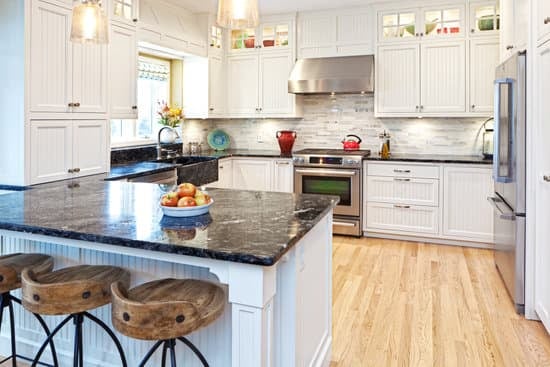Are you considering making improvements to your home and wondering if your insurance will cover them? This article will help you understand the ins and outs of homeowner’s insurance and how it relates to home improvements.
Homeowner’s insurance is designed to protect your home, personal property, and provide liability coverage for accidents that may occur on your property. But what type of insurance includes improvements to a home? We’ll explore the specific details in this article.
When it comes to coverage for home improvements under homeowner’s insurance, there are important factors to consider. From the types of home improvements covered to the process of adding them to your insurance policy, we’ll provide valuable insights to help you navigate this aspect of homeownership.
In addition, we’ll delve into cost considerations for insuring home improvements and provide tips for choosing the right insurance policy. We’ll also highlight common mistakes to avoid when insuring home improvements, as well as real-life case studies of home improvements covered by insurance. By the end of this article, you’ll have a clear understanding of how to ensure your peace of mind with the right insurance for your home improvements.
Coverage for Home Improvements Under Homeowner’s Insurance
Homeowner’s insurance is designed to protect your home and its contents in the event of damage or loss due to covered perils. This type of insurance typically covers damage to the structure of your home, as well as personal belongings inside the home. However, many people wonder what type of insurance includes improvements to a home. In this section, we will explore how homeowner’s insurance can provide coverage for home improvements.
Coverage for home improvements under homeowner’s insurance can vary depending on the specific policy and insurance provider. It’s important for homeowners to review their policy and speak with their insurance agent to understand what types of home improvements are covered. Some common types of home improvements that may be covered by homeowner’s insurance include:
- Adding a new room or extension
- Remodeling a kitchen or bathroom
- Upgrading electrical or plumbing systems
- Installing a new roof or siding
When considering coverage for home improvements, it’s important to understand the process of adding these improvements to your insurance policy. This may involve assessing the value of the improvements and updating your coverage limits accordingly. Additionally, homeowners should consider the cost implications of insuring home improvements, including any potential increases in premiums.
In order to ensure peace of mind with the right insurance for home improvements, homeowners should carefully review their policy options and consider working with an experienced insurance agent. By understanding what types of home improvements are covered by homeowner’s insurance and taking steps to update their policy as needed, homeowners can protect their investment in their property and enjoy added confidence in their coverage.
Types of Home Improvements Covered
When it comes to homeowner’s insurance, understanding what type of insurance includes improvements to a home is essential. Home improvements can significantly increase the value of your property, and it’s important to ensure that they are adequately covered by your insurance policy.
Structural Improvements
Structural improvements are an essential part of any home, and it’s crucial to have them covered by your insurance. This can include additions such as a new room, a garage, or even a swimming pool. These types of improvements can often be expensive to repair or replace, so having them included in your insurance coverage is crucial for protecting your investment.
Remodeling and Renovations
Many homeowners choose to undertake remodeling or renovations to improve the aesthetic appeal and functionality of their homes. Whether it’s a kitchen renovation, bathroom upgrade, or new flooring throughout the house, these improvements should also be considered when reviewing your homeowner’s insurance policy. This coverage can help protect the value added by these upgrades in case of damage or loss.
Energy Efficiency Upgrades
With an increasing focus on sustainability and energy efficiency, many homeowners are making upgrades to their homes such as installing solar panels, energy-efficient windows, or upgrading their HVAC systems. These types of improvements not only add value but also reduce long-term utility costs. It’s important to ensure that these upgrades are adequately covered by your homeowner’s insurance in case of any unforeseen damage.
Understanding the types of home improvements covered under homeowner’s insurance is crucial for ensuring that your investment is protected. When reviewing your policy, make sure to discuss these specific types of improvements with your insurance provider to ensure that they are adequately covered in case of any unfortunate events.
The Process of Adding Home Improvements to Insurance Coverage
When it comes to making significant improvements to your home, it’s essential to ensure that your homeowner’s insurance policy adequately covers these upgrades. Adding home improvements to your insurance coverage can provide you with the peace of mind knowing that your investment is protected in case of any unforeseen events. Here are some important steps to consider when adding home improvements to your insurance coverage:
1. Assess Your Current Coverage: The first step in the process is to review your existing homeowner’s insurance policy. Determine what type of coverage you currently have and whether it includes provisions for home improvements. Understanding the extent of your current coverage will help you identify any gaps that need to be addressed.
2. Consult with Your Insurance Provider: Once you have assessed your current coverage, it’s important to consult with your insurance provider to discuss adding the new home improvements to your policy. They can provide valuable information about the specific types of upgrades that can be covered and any limitations or requirements for doing so.
3. Document the Home Improvements: To ensure that your home improvements are adequately covered, it’s crucial to keep detailed documentation of the upgrades made to your property. This can include receipts, contracts, and photographs of the renovations. Having this documentation on hand will be beneficial in case you need to file a claim in the future.
By following these steps and working closely with your insurance provider, you can seamlessly add home improvements to your insurance coverage without any hassle. Taking these proactive measures will help protect your investment and provide you with the assurance that comes with having comprehensive insurance coverage for your home improvements.
Cost Considerations for Insuring Home Improvements
When it comes to insuring home improvements, cost considerations play a crucial role in determining the right insurance policy for your needs. Whether you’re adding a new room, renovating your kitchen, or installing a swimming pool, it’s important to understand the financial implications of insuring these upgrades.
Assessing the Value of Home Improvements
Before you can determine the cost of insuring home improvements, you need to assess the value that these upgrades add to your property. This can involve getting an appraisal or valuation from a professional to understand how much the improvements increase the overall value of your home. This step is essential in ensuring that you have adequate coverage in case of damage or loss.
Impact on Premiums
Adding home improvements to your insurance coverage may impact your premiums. Insurance companies take into account the increased value of your home and potential risks associated with the upgrades. It’s important to discuss these changes with your insurance provider so that you can budget accordingly and avoid any surprises when it comes time to pay premiums.
Policy Limits and Deductibles
Understanding how policy limits and deductibles apply to home improvements is another crucial cost consideration. Depending on the type and value of the upgrades, you may need to adjust these limits and deductibles to ensure adequate coverage. Working closely with your insurance agent or broker can help you navigate this aspect of insuring home improvements effectively.
By carefully considering the costs associated with insuring home improvements, homeowners can make informed decisions about their insurance policies, ensuring they have peace of mind knowing their investments are protected against unforeseen circumstances.
Tips for Choosing the Right Insurance Policy for Home Improvements
When it comes to choosing the right insurance policy for home improvements, there are a few key tips to keep in mind. Firstly, it’s important to review your existing homeowner’s insurance policy and understand what type of coverage it provides for home improvements. Many standard policies may not offer sufficient coverage for extensive renovations or additions, so you may need to consider additional options.
One essential tip for choosing the right insurance policy for home improvements is to assess the value of the upgrades you plan to make. This will help you determine the amount of coverage you need to adequately protect your investment. Keep in mind that some types of home improvements may increase the replacement cost of your home, so it’s crucial to update your insurance policy accordingly.
Another important factor to consider when selecting an insurance policy for home improvements is to research different insurance providers and compare their offerings. Look for specialized policies that specifically cater to homeowners who are planning renovations or major upgrades. Consider factors such as coverage limits, deductibles, and premium costs when evaluating different options.
Additionally, seek advice from an experienced insurance agent who can provide guidance on selecting the right policy for your specific home improvement needs. An agent can help you understand the intricacies of different insurance options and assist in finding a policy that offers comprehensive coverage for your planned renovations. By following these tips, you can ensure that you choose a suitable insurance policy that includes provisions for protecting your valuable home improvements.
Common Mistakes to Avoid When Insuring Home Improvements
Coverage for home improvements is an important consideration for homeowners, as it can provide financial protection in the event of damage or loss. Many people wonder, what type of insurance includes improvements to a home? The answer lies in homeowner’s insurance, which typically includes coverage for home improvements. This type of insurance is designed to protect the structure of your home and its contents, including any upgrades or renovations that have been made.
When it comes to insuring home improvements, it’s crucial to understand what types of improvements are covered under homeowner’s insurance. Generally, standard policies provide coverage for structural changes or additions to your home, such as adding a new room or renovating a kitchen or bathroom. However, it’s important to review your policy carefully and consult with your insurance provider to ensure that specific improvements are included in your coverage.
The process of adding home improvements to your insurance coverage involves assessing the value of the improvements and updating your policy accordingly. This may require obtaining appraisals or estimates for the cost of the improvements, and then working with your insurance provider to adjust your coverage limits and premiums. It’s also important to keep detailed records of any home improvement projects, including receipts, contracts, and photographs, as this documentation will be essential in the event of a claim.
Case Studies
When it comes to home insurance, many homeowners wonder what type of insurance includes improvements to a home. Homeowner’s insurance typically covers the cost of repairing or rebuilding a home in the event of damage or destruction caused by covered perils such as fire, windstorm, or theft. However, it’s important to understand that not all home improvements are automatically covered under a standard homeowner’s insurance policy.
Certain types of home improvements may be eligible for coverage under homeowner’s insurance, such as adding a new roof, upgrading electrical systems, or remodeling a kitchen. These improvements are considered to add value to the home and may be included in the replacement cost coverage of the homeowner’s insurance policy.
It’s important for homeowners to carefully review their homeowner’s insurance policy and speak with their insurance agent to determine what type of home improvements are covered. Additionally, certain types of specialty insurance policies, such as renovation insurance or home improvement insurance, may provide coverage specifically for renovations and upgrades to a home. This type of insurance can help protect the financial investment made in improving the home.
| Types of Home Improvements Covered | Examples |
|---|---|
| New Roof | Replacing an old roof with a new one |
| Kitchen Remodel | Upgrading appliances and countertops in the kitchen |
Conclusion
In conclusion, it is crucial for homeowners to understand the extent of their homeowner’s insurance coverage when it comes to home improvements. Adding new features or making significant upgrades to a property can increase its value, and it’s important to ensure that these improvements are adequately covered in case of damage or loss.
This article has shed light on the different types of home improvements that can be covered under homeowner’s insurance, as well as the process of adding them to an existing policy.
When considering the right insurance policy for home improvements, it’s essential for homeowners to carefully assess their needs and consult with their insurance provider to understand what type of insurance includes improvements to a home. By doing so, they can ensure that their peace of mind is maintained, knowing that their investments in home improvements are protected. Cost considerations should also be taken into account, as insuring home improvements may require additional premiums or adjustments to existing policies.
By learning from common mistakes and exploring real-life case studies of home improvements covered by insurance, homeowners can make informed decisions about selecting the right coverage for their specific situation. Ultimately, having the right insurance for home improvements not only provides financial protection but also offers peace of mind knowing that one’s most significant asset is safeguarded.
So take the time to research and review your homeowner’s policy and seek advice from your insurer so you can make sure your home improvement investments are properly protected.
Frequently Asked Questions
What Are the Three Main Types of Homeowners Insurance?
The three main types of homeowners insurance are HO-1, HO-2, and HO-3. HO-1 is a basic policy covering 10 specific perils, HO-2 is a bit more comprehensive covering 16 perils, and HO-3 is the most common type providing broad coverage for the structure of your home.
What Is the Difference Between HO3 and Ho6 Insurance?
The main difference between HO3 and HO6 insurance is the type of property they cover. HO3 insurance is for single-family homes while HO6 insurance is designed for condominium owners. Additionally, HO6 typically covers the interior walls and personal property, while HO3 covers the entire structure of a single-family home.
What Type of Insurance Will Cover Problems That Happen to Your House?
Homeowners insurance typically covers problems like fire damage, windstorm damage, theft, vandalism, and certain types of water damage. It also provides liability coverage in case someone is injured on your property. Be sure to review your policy to understand what specific problems are covered.

I’m thrilled to have you here as a part of the Remodeling Top community. This is where my journey as an architect and remodeling enthusiast intersects with your passion for transforming houses into dream homes.





